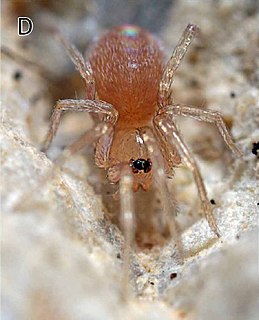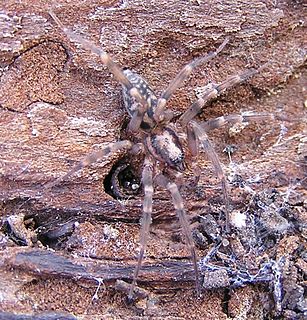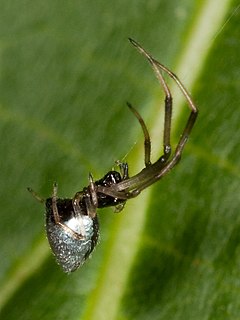
Oonopidae, also known as goblin spiders, is a family of spiders consisting of over 1,600 described species in about 113 genera worldwide, with total species diversity estimated at 2000 to 2500 species. The type genus of the family is OonopsKeyserling, 1835.

The spur-winged lapwing or spur-winged plover is a lapwing species, one of a group of largish waders in the family Charadriidae.

Liocranidae is a family of araneomorph spiders first described by Eugène Simon in 1897. They are one of several groups called "sac spiders". The holarctic genus Agroeca is the best-known, but it also includes various genera of more obscure spiders that still lack a diagnosis. Two species in the North American genus Neoanagraphis are found in the extremely dry conditions in the Mojave, Sonoran and Chihuahuan deserts. Females live in animal burrows while males wander and are the ones most often caught in pitfall traps.

Acanthus is a genus of about 30 species of flowering plants in the family Acanthaceae, native to tropical and warm temperate regions, with the highest species diversity in the Mediterranean Basin and Asia. This flowering plant is nectar producing and is susceptible to predation by butterflies, such as Anartia fatima, and other nectar feeding organisms. Common names include Acanthus and Bear's breeches. The generic name derives from the Greek term ἄκανθος (akanthos) for Acanthus mollis, a plant that was commonly imitated in Corinthian capitals.

Trap-jaw ants are a genus (Odontomachus) of omnivorous ants found in the tropics and subtropics throughout the world.
Enoplomischus is a genus of African jumping spiders that was first described by L. Giltay in 1931. As of June 2019 it contains only two species, found only in Africa: E. ghesquierei and E. spinosus. They have a large spike-like process on its pedicel that probably mimics a similar spike present in the anterior part of the abdomen of Odontomachus ants that these spiders seem to be modeled after.
Langelurillus is a spider genus of the family Salticidae. All the described species occur only in Africa.
Macopaeus is a genus of jumping spiders endemic to Madagascar. It contains only one species, Macopaeus spinosus. Two other species were described in this genus in the early 20th century. However, these were transferred to the genus Brettus in 1980.

Cyatholipidae is a family of spiders first described by Eugène Simon in 1894. Most live in moist montane forest, though several species, including Scharffia rossi, live in dry savannah regions. They occur in Africa, including Madagascar, New Zealand and Australia, and one species in Jamaica. Most members of this family hang beneath sheet webs. Fossil species occur in the Eocene aged Bitterfield and Baltic Ambers, suggesting a wider geographic distribution in the past.

Mysmenidae is a spider family with about 135 described species in thirteen genera. The family is one of the least well known of the orb-weaving spiders because of their small size and cryptic behaviour. These spiders are found in humid habitats such as among leaf litter and in caves.

Argyrodes, also called dewdrop spiders, is a genus of comb-footed spiders that was first described by Eugène Louis Simon in 1864. They occur worldwide, and are best known for their kleptoparasitism. They can spin their own webs, but tend to invade and reside in their hosts' webs. This relationship can be commensal or even mutual if the dewdrop spider feeds on small trapped insects that are not eaten by the host. Some species can even prey upon the host.
Neacomys spinosus, also known as the common neacomys, common bristly mouse, or bristly mouse, is a nocturnal rodent species from South America in the genus Neacomys. It is found in Bolivia, Brazil, Colombia, Ecuador and Peru, where it often lives in transition areas between lowland forest and open regions. Its diet consists of insects, seeds and fruit.

Spiders are air-breathing arthropods that have eight legs, chelicerae with fangs generally able to inject venom, and spinnerets that extrude silk. They are the largest order of arachnids and rank seventh in total species diversity among all orders of organisms. Spiders are found worldwide on every continent except for Antarctica, and have become established in nearly every habitat with the exceptions of air and sea colonization. As of May 2021, at least 49,800 spider species in 129 families have been recorded by taxonomists. However, there has been dissension within the scientific community as to how all these families should be classified, as evidenced by the over 20 different classifications that have been proposed since 1900.

Achaeus spinosus is a small decapod which belongs to the large family of the Inachidae or the spider crabs.
Euphrictus spinosus is a tarantula, subfamily Selenogyrinae, first described by A.S. Hirst in 1908. It is only known from the male, and from the Dja River, Cameroon.
Euphrictus is a genus of tarantula which is found in Africa. It is part of the subfamily Selenogyrinae.
Pseudonesticus is a genus of spiders in the family Nesticidae. It was first described in 2013 by Liu & Li. As of 2017, it contains 6 species, all from China.

Siamspinops is a genus of Asian wall spiders that was first described by P. Dankittipakul & J. A. Corronca in 2009. It was merged with the monotypic genus Pakawops in 2019.
Kima montana is a jumping spider that lives in Kenya.
Leptorchestes separatus is a jumping spider species in the genus Leptorchestes that lives in Namibia. It was first described in 2001.










